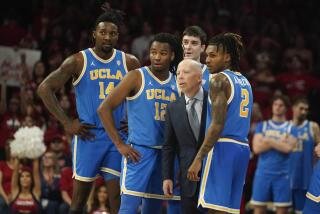NEXT L.A.: A look at issues, people and ideas helping to shape the emerging metropolis. : The New M-TV : Medical diagnoses of patients across the country are possible through telemedicine--a fiber-optic cable linkup at UCLA.
- Share via
Sitting comfortably in his swivel chair, facing a computer console, Dr. Robert B. Lufkin goes to work.
Lufkin, a radiologist at the UCLA Medical Center, specializes in reading neurological images--”Everything from the neck up”--and the bright screen in front of him has his full attention.
On the screen are 24 CAT-scan views of a female patient’s head. Lufkin is looking for evidence of cancerous growths. With the touch of a button he can zoom in on various tissues and look at top views or side views.
He spots trouble under the tongue, a mass on the floor of the mouth. A possible tumor.
He calls the woman’s doctor, and within minutes has briefed him.
What is unusual about this scene is that Lufkin is in Los Angeles and the images he is examining were sent to UCLA over fiber-optic cable from a radiological lab in Melbourne, Fla., just minutes before.
Lufkin is the final link in what is thought to be the nation’s first transcontinental telemedicine service. Several times a day, UCLA specialists examine scans of knee injuries, ultrasounds, mammograms and heart scans taken more than 2,500 miles away.
So far, what is part experiment in the future of medicine and part pragmatic effort by a company in Florida to cap its health costs is a smashing success.
For UCLA, the arrangement makes sense because it could open a potentially huge market for the medical school’s radiology department. Radiologists at UCLA could some day have customers worldwide, each connected to Westwood by signals bounced off satellites and sent to the university over fiber-optic cables.
The Florida company, Harris Corp., is in the electronic imaging business and saw the promise of a new product. But firm executives also said they were interested in saving their own company millions of dollars in employee health care costs.
Those involved with telemedicine, which has been in use by the military but slower to catch on in the health fields, say it has almost limitless possibilities for patients in Los Angeles and elsewhere. At some point, the link now established between UCLA and the imaging center in Florida could extend to small clinics around Los Angeles and physicians’ offices from Lancaster to Long Beach.
Elsewhere in California, telemedicine is said to have great potential for bringing sophisticated health services to rural areas.
A heart attack victim in a remote region might typically have to be taken to a small rural hospital, then flown or driven to a specialty care hospital, perhaps hundreds of miles away. With an electronic hookup, the patient could stay at the rural hospital, with diagnosis and treatment guided by specialists elsewhere.
“For me as the radiologist, it is immaterial whether the image comes from 20 yards away or 2,000 miles away,” said Lufkin, 42, who studied computer science as an undergraduate at the University of Virginia. “The quality is the same. The interpretation I make is the same.”
A big advantage is being able to tap into UCLA’s vast physician resources, including radiologists practicing 14 subspecialties. “We have been able to provide a level of radiology services to our patients that are not readily available in this community,” said Frank Bright, chief executive of University Center Imaging in Melbourne, Fla., which provides radiology services to Harris employees.
Few hospitals can afford the luxury of a radiologist like Lufkin who does nothing but analyze particular parts of the body. UCLA also has radiologists who specialize in parts of the body such as the knee, kidneys, urinary system and breasts.
“With this kind of technology, this kind of expertise potentially can be delivered to any patient anywhere in the United States,” said Dr. Richard Steckel, chairman of the department of radiology.
Sometimes, the expertise available at UCLA helps identify unusual medical conditions. Dr. Theodore R. Hall, a pediatrics specialist, remembers an early Florida patient.
A child came into the Florida imaging center with what doctors said was “a cough and fever.” Physicians performed a chest X-ray and found a huge cloudy mass.
“They didn’t know what it was, so they did a CAT scan while the child was there in the center,” Hall said. “When they got the CAT scan images, it was even more confusing to them. They had never seen anything that looked like this in the chest of a child.”
Hall said when he looked at the images on the monitor at UCLA, he spotted what he thought was a tumor, likely non-malignant, that develops in a relatively unusual form of childhood cancer. The tumor was removed and the child is no longer in danger.
On the particular day that Lufkin found the growth in the Florida woman’s mouth, the physician at the other end of the line in Florida was Dr. Konrad A. Kirlew, a radiologist in Melbourne.
He and Lufkin got into a short, intense and highly technical medical discussion, rich with multisyllabic words. Lufkin told Kirlew what he saw, but just as important, what he didn’t see.
In the past, the physicians who initially discovered the growth might have gone into surgery immediately. But Lufkin could tell, based on studying thousands of similar images in other patients, that the mass was possibly cancerous, though well-contained, and could be dealt with without surgery.
“This empowering technology makes things possible that weren’t possible 10 years ago,” Lufkin said.






